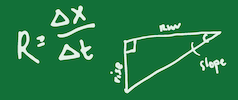Guiding Students through Scientific Notation
An Instructor's Guide to Scientific Notation
Antony Kinyua, Morgan State University
Jeff Clark, Lawrence University
What Should Students Get out of This Module?
After completing this module, a student should be able to:
- Write large or small numbers in scientific notation.
- Convert scientific notation format to standard decimal format.
Why Are These Math Skills Challenging to Incorporate into Courses?
It is often surprising to faculty that students have difficulty with scientific notation. There are several reasons why they may:
- Although very compact and useful, we don't often use scientific notation everyday life. We don't think of the world population as 7 x 109 people, instead we say "seven billion."
- This is a topic often taught in middle school, so students may not have encountered this way of representing numbers for several years (or ever).
- Most calculators and spreadsheets do not represent scientific notation as we write it. To add to the confusion, different manufacturers and programmers use different ways of representing exponents (e.g., EEX, EX, or using a "caret" ^).
What Don't We Include in the Page?
Our aim is to devote this page solely to the converting between scientific notation and decimal notation. Once this skill is mastered, students can then use scientific notation to solve problems. Those problems will involve concepts that are not covered here but are covered elsewhere (see resources below, for example). Those that are not covered include:
- Significant digits
- Rearranging equations to solve for an unknown.
- Unit conversions
- Algebraic rules for multiplying and/or dividing exponents.
Instructor Resources
Support for teaching this quantitative skill
- Big Numbers. In general, students have difficulty with two things when dealing with numbers that have more zeros (either before or after the decimal point) than they are used to. They often do not understand "big" and "small" are relative terms, the concept of "order of magnitude."
- "Scientific Notation." Scientific notation is a way to assess the order of magnitude and to visually decrease the zeros that the student sees. It also may help students to compare very large (or very small numbers). But students still have little intuition about scientific notation. Teaching them to recognize that scientific notation is a shorthand way to better understand big and small numbers can be useful to them in all aspects of their academic career.
- Orders of Magnitude is a Math You Need module to help students determine the order of magnitude of numbers.
- Teaching with Equations (carleton.edu) and Rearranging Equations are good supplemental pages that are useful for problems that require the separation of variables. Teaching students to make connections between the physical world, words, and equations is a fundamental skill for geoscientists because they are all interconnected. Helping students realize these connections will build their confidence for using mathematics in a meaningful way.
- Significant Digits and Significant Figures. Significant figures are the number of digits in a value, often a measurement, that contribute to the degree of precision of the value. We start counting significant figures at the first non-zero digit. Some rules to remember: All non-zero digits are significant. Zeros are also significant with two exceptions: zeros preceding the decimal point and zeros following the decimal point that precede the first non-zero digit.
Examples of activities that use this quantitative skill
- Estimating the Volume of Olympus Mons. In this activity, students are challenged to calculate and compare the volume of Olympus Mons to the Hawaiian Islands, by assuming a cone shape for the volcanoes.
- Toilet Paper Analogy for Geologic Time (carleton.edu). This demo involves about 1000 sheet rolls of toilet paper (Scott tissue recommended) to demonstrate the vast length of time involved in Deep Time (or geologic time). Important events in geologic history (such as the extinction of the dinosaurs, or the Stone Age) are marked on toilet paper. As the toilet paper is unrolled, from the front of the room to the back and around the room, students begin to get a sense of how little time humanity has been on Earth and how much time is really involved.
- Eliminating trays in the cafeteria: Benefits to the planet and to economic costs; (carleton.edu). Students collect data and information on using food trays in the cafeteria. They analyze the environmental and cost benefits of eliminating food trays in the cafeteria and prepare a written report of their findings. To conclude the project, they make a presentation for the college president.
